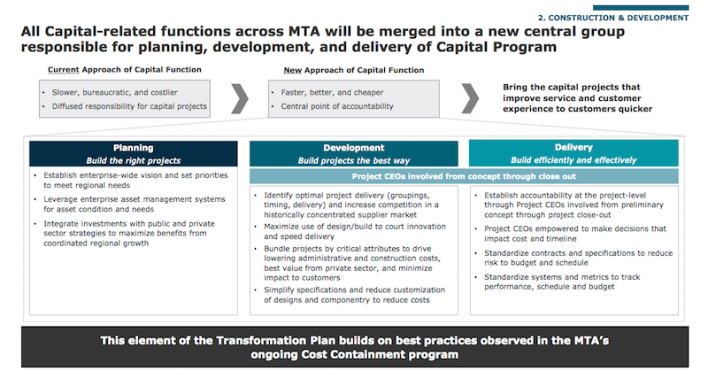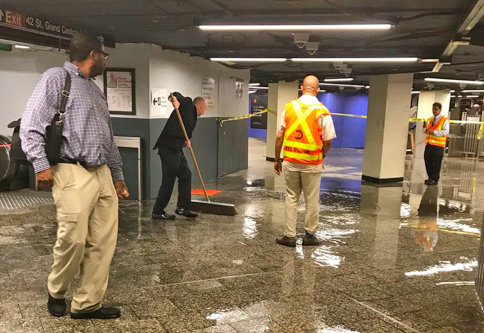The MTA's draft consolidation report, released late Friday, is already being criticized for possibly stripping the city's subway chief of his ability to bring the system up to modern standards, and of misidentifying the actual reasons for why the subway has improved over time.
The AlixPartners report — commissioned by Gov. Cuomo — is meant to guide the authority through a reorganization into a sleeker, cheaper agency. And it does offer recommendations, such as combining supposedly redundant functions like human resources, public communications, engineering standards, data management, and most controversially, capital construction projects. It also proposes four new executive positions at the MTA to oversee the areas of engineering, accessibility, the division presidents and the consolidation effort itself.
"Through centralization, simplification, standardization, planning and empowering staff to change the way the MTA does business, the organization could more effectively deliver a transportation system that the region deserves," the report authors write.
Consolidation — what critics like to call trimming "the fat" — isn't always so easy in an agency which includes disconnected divisions that run New York City's subways and buses, several suburban railroads, and a handful of bridges and tunnels. A previous effort to consolidate back office functions, the Business Service Center, was derided by an MTA watcher. "I don’t know anybody who loves the BSC," the observer told Streetsblog of the unit, which double-paid vendors to the tune of $3 million in 2011.
The $4-million AlixPartners report is more expensive than the combined salaries of Met and Yankee all-stars Pete Alonso, Jeff McNeil, Gleyber Torres and Gary Sanchez, who are being paid $2,397,714 this season. That quartet of young superstars has combined for 12 wins above replacement and has captivated baseball fans locally and nationwide. The MTA Transformation report was called "dull" and "unremarkable" by more charitable observer, and scorned by other transit observers.
TransitCenter's Ben Fried criticized the report's proposal to consolidate capital-related functions into what its authors called "a new central group responsible for planning, development and delivery" of an MTA-wide capital program. Major plans, like New York City Transit President Andy Byford's "Fast Forward" subway modernization effort, would end up being overseen by the larger entity, removing power from the direct supervisor.
"Folding capital construction under a central entity may exacerbate the problems it’s intended to solve," Fried said in a statement. "Because capital work on subway tracks and stations has a direct impact on service delivery, and vice versa, it’s also essential to tightly integrate these two functions within the transit agency. Separating capital work from NYCT within the MTA bureaucracy will have the opposite effect."
Fried also noted that MTA Capital Construction has not delivered on the promises of cheaper and on-time mega-project oversight since the unit was developed in 2003. Even with the Capital Construction unit, the first phase of the Second Avenue Subway still cost a worst-in-the-world $1.3 billion per mile. And cost overruns have continued to haunt the East Side Access project.

Nick Sifuentes of the Tri-State Transportation Campaign called the report a "laughable ... revisionist history" that focuses on the unsustainable, overtime-heavy Subway Action Plan as a model for saving the system.
"The AlixPartners ‘plan’ relies heavily on the purported ‘success’ of the governor’s Subway Action Plan, which has been wildly overstated by its proponents," Sifuentes said in a statement. "If this plan relies on the SAP process as justification for wholesale change at the MTA, that foundation is pretty thin."
There is an ongoing question of whether the Subway Action Plan's focus on overtime-driven maintenance work, necessary after years of neglect, has been more of a key driver of improving the subway's weekday on-time performance over the last year or if the improving timeliness has more to do with the MTA simply allowing train operators to run trains faster where they can safely do so.
This draft plan is the first step in the process to lock in the upcoming attempt to create the MTA II. The next step is for the MTA Board to vote on the plan by the end of July, and a period of public input before the final reorganization report is delivered to the board by the end of October.
Danny Pearlstein of the Riders Alliance stressed that the next steps in the reorganization plan have to include "a thorough public vetting and ample time to evaluate the proposals" so that whatever plan is adopted actually results in better service for riders.






